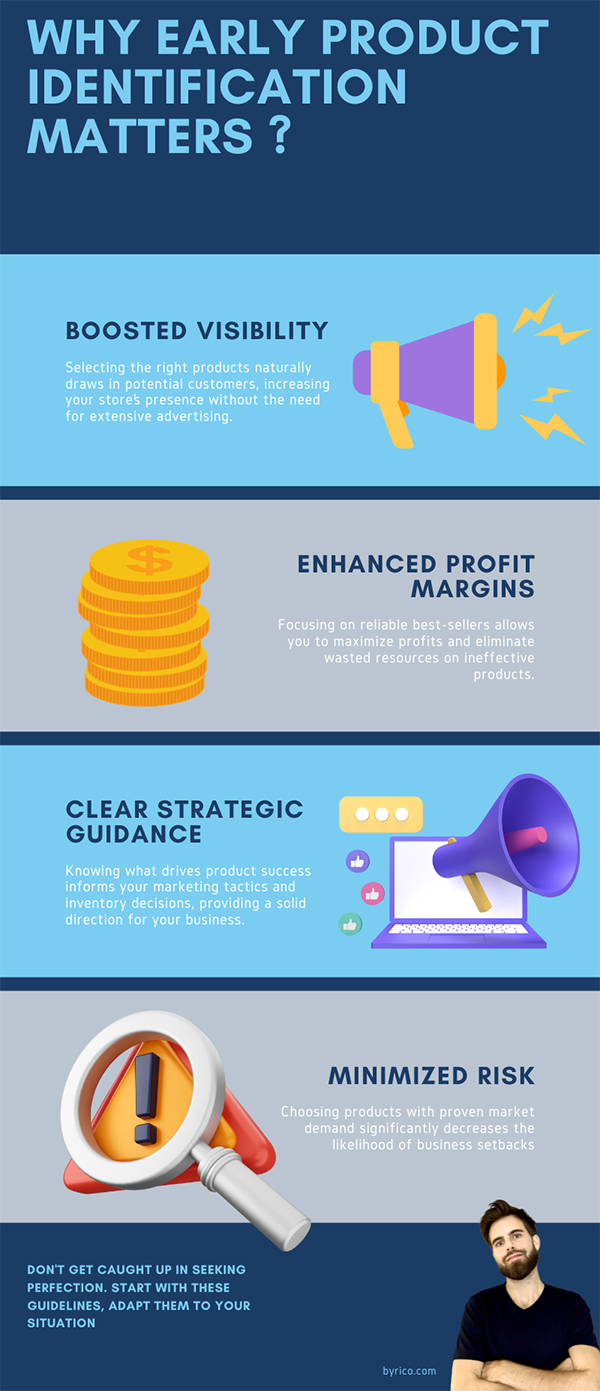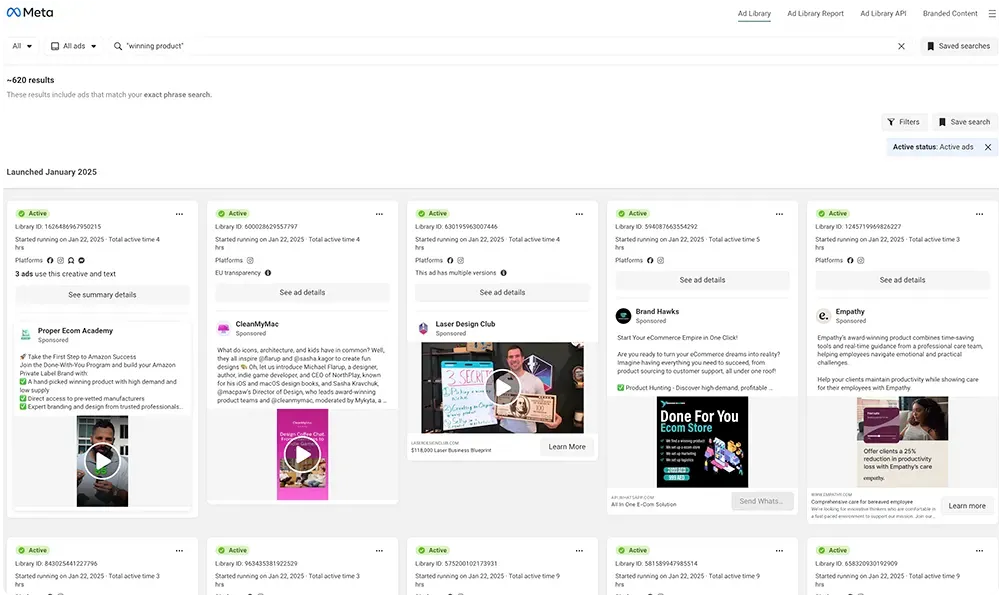Your First Product Research, A No-BS Approach
So you've watched 100 hours of YouTube videos and feel ready to jump into product research? One last piece of advice won't hurt.

Let's break down the real concepts behind successful product research and build solid foundations for your ecommerce venture.
Understanding Winning Products in Ecommerce
Before diving into the tactics, let's understand what makes a product worth your time and investment. This knowledge is crucial when you're just starting out.
Core Characteristics of Winning Products
- Problem-Solving Capability: Your product needs to address real issues or fulfill genuine desires. Think portable phone chargers, they solve the universal problem of battery anxiety.
When a product fixes a clear pain point, marketing becomes significantly easier. - Unique and Eye-Catching Features: Standing out in the crowded ecommerce space is crucial. This doesn't mean your product needs to be revolutionary, sometimes a unique twist on a common item is enough.
The key is having something that stops people from scrolling past your ads. - Demand-Competition Balance: The sweet spot is finding products with high demand but manageable competition levels.
This gives you room to enter the market without fighting an uphill battle against established players. - Proven Sales Performance: Look for products showing consistent sales patterns. While new products can succeed, having proof of market demand reduces your risk significantly.

Why Early Product Identification Matters
Getting good at spotting winning products early gives you several advantages:
- Traffic Generation: A well-chosen product naturally attracts potential customers, boosting your store's visibility without requiring massive ad spend.
- Better Profitability: When you focus on proven sellers, you can optimize your margins and avoid wasting resources on dead-end products.
- Strategic Direction: Understanding what makes products successful helps shape everything from your marketing approach to inventory management.
- Risk Reduction: Starting with products that have demonstrated market demand significantly lowers your chance of failure.

Product Research Strategies what they say on internet?
Professional Research Resources
- Trend Publications
- Follow industry leaders like Trend Hunter and PSFK
- Stay updated on emerging consumer interests
- Track market movements and upcoming trends
- Amazon Intelligence
- Monitor Amazon's bestseller lists (updated hourly)
- Use tools like Jungle Scout for deeper analytics
- Track sales patterns, competition levels, and product variations
- Social Media Research
- Focus on TikTok trends #TikTokMadeMeBuyIt
- Monitor Instagram shopping trends
- Analyze engagement patterns and consumer reactions
- Community Intelligence
- Participate in niche-specific forums
- Join relevant Facebook groups
- Monitor Reddit communities in your target market
- B2B Marketplace Analysis
- Study wholesale platforms like Alibaba
- Track emerging product trends among businesses
- Analyze supplier ratings and capabilities
Essential Research Tools
- Niche Scraper: Perfect for identifying trending products within specific markets
- SimilarWeb: Analyze competitor traffic and audience demographics
- AMZScout: Amazon product metrics
- Helium 10: Comprehensive Amazon research suite
- Facebook Ads Library: Spy on competitor advertising strategies

My Personal Blueprint for Product Research Success
Let me break down my actual process... this isn't theoretical BS, but what actually works in the real world (disclaimer: based on my personal experience)
The Step-by-Step Process
- Social Media Validation
- Start with TikTok/Instagram
- Look for organic engagement, not just paid promotion
- Track comment sentiment and user interest
- Note down products generating genuine excitement
- Amazon Order Volume Analysis
- Check last month's sales numbers
- Use research tools to verify demand
- Look for consistent sales patterns
- Analyze price points and profit margins
- Supply Chain Verification
- Cross-reference on AliExpress/Alibaba
- Verify order volumes from suppliers
- Check supplier ratings and history
- Assess shipping times and costs
- Deep Review Analysis
- Focus on negative reviews first
- Look for recurring quality issues
- Assess customer service requirements
- Identify potential improvement areas
- Competitor Analysis
- Identify main players in the space
- Study their marketing approaches
- Analyze pricing strategies
- Look for market gaps
- Ad Campaign Research
- Study competitor ad strategies
- Analyze successful ad creatives
- Note targeting approaches
- Understand seasonal patterns
Practical Considerations for Beginners
Product Selection Guidelines
- Avoid Complexity: Stay away from electronics and complicated gadgets when starting
- Keep It Simple: Choose products with minimal potential for malfunction
- Price Point Wisdom: Start with items that allow for good profit margins while staying affordable
- Quality Control: Ensure your product can handle some returns without destroying your profits
The Testing Budget Formula
Here's a practical formula from a successful media buyer for facebook ADS (based on real-world experience):
Daily Testing Budget = 5 × Expected Average Order Value (AOV)
Total Testing Period = 14 days minimum
Total Testing Budget = (AOV × 5) × 14
Example for a $20 product:
- Daily testing budget: $20 × 5 = $100
- Total testing budget: $100 × 14 = $1,400
This isn't a guaranteed success formula, but it provides a realistic starting point based on actual market experience.

The Truth About Product Selection
Let's bust some myths about "problem-solving products." While solving problems is great, some of the biggest successes I've seen came from basic, everyday items. Success isn't always about:
- Having the most innovative product
- Creating something completely new
- Following guru advice blindly
- Using aggressive marketing tactics
What Really Matters
Focus on:
- Finding genuine product-market fit
- Learning from each failure
- Improving your process constantly
- Understanding your specific market
- Building sustainable systems
Whether you're selling pet accessories, home decor, or fashion items, success comes from understanding your market and executing well, not from following rigid rules or chasing perfect products.
Final Thoughts on Successful Product Research
Remember that successful ecommerce isn't about finding one magical product. It's about:
- Developing a systematic approach to product research
- Building a reliable testing process
- Learning from each iteration
- Staying adaptable to market changes
- Focusing on sustainable growth
Don't get caught up in seeking perfection. Start with these guidelines, adapt them to your situation, and keep improving your process. The key is getting started and learning from real market feedback, not endless preparation or guru talks.
